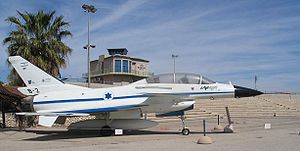| Lavi | |
|---|---|
| Lavi B-2 prototype | |
| Role | Multirole fighter |
| Manufacturer | Israeli Aircraft Industries |
| First flight | 31 December 1986 |
| Status | Cancelled 30 August 1987 |
| Number built | 2 prototypes (5 planned) |
Contents
|
History
The Lavi project began in February 1980, when the Israeli government authorized the IAF to present it with a list of technical specifications for the development of the IAF's future fighter. The development stage began in October 1982, with the choice of a Pratt & Whitney engine already having been made.One of the Lavi's most distinct advantages is its functional features, especially its cockpit, custom-built entirely using input from active IAF fighter pilots. Drawing on their operational experience, the design was geared to let the pilot handle the tactical aspects of the battle, without having to worry about monitoring and controlling the various subsystems. The avionics of the Lavi were considered to be innovative and groundbreaking, and included self-analysis equipment to make maintenance easier.[citation needed]

An IAI lavi nose on display in Beer-Sheva.
On December 31, 1986, the first prototype of the Lavi took off on its maiden flight. The test pilot, Menachem Shmul, head of IAI's Air Operations section, took off at 13:21 and stayed in the air for 26 minutes, during which he checked the engine and controls.

An IAI lavi displayed during a celebration of Israel's independence
The IAI had produced three prototypes out of the originally planned five when the Israeli government decided to cancel the project because of budget problems and bickering among various economic and political pressure groups. The total cost for the development and production of the Lavi was US$6.4 billion in 1983 ($14.1 billion in present-day terms[1]), of which around 40% was funded by the United States and 60% by the Israeli government. The project was canceled in part because the U.S. was not prepared to finance an aircraft that would compete in the export market with the F-16C/D and the F/A-18C/D, and also because a dispute arose as to the final cost. The Israeli government was unable to finance the project alone and canceled it on August 30, 1987.[2] The decision to cancel was approved with a majority of only one vote. Two years after the project's cancellation, the IAI has completed the building of the third Lavi prototype, which served as a Technology Demonstrator (TD) and a flying testbed to some of the IAI's projects. The TD flew until the mid nineties, and was later used as a ground testbed.
Throughout the project's lifetime, Likud minister Moshe Arens, himself an IAF veteran, was the Lavi's main advocate. However, the military was not of one mind on the issue. A counter-argument was that the Lavi did not represent a sufficient advance over the F-16 or other comparable aircraft to justify its higher cost, and Israel was better off buying larger numbers of the American plane. Some community welfare organizations in Israel blasted the spending associated with the Lavi as a bottomless pit, and contrasted it with dwindling expenditure on health and education.
However, while the Lavi project was canceled, its development represented an important opportunity to demonstrate and advance the capabilities of Israel's aerospace industry; moreover, many of the aircraft's sub-systems and components continued to be developed by the Israeli aerospace industry and are nowadays available in the defense marketplace as separate systems, contributing to Israeli exports.
According to some sources China was in possession of a Lavi during development of the J-10.[3] Furthermore, due to the high level of American involvement in terms of technology sharing as well as funding, if these allegations were proven true, the sale of a Lavi and technical assistance in the production of the J-10 would represent a direct and illicit transfer of American technology to the Chinese by the Israelis. In sum, to a degree, the most advanced Chinese aircraft in the world would contain the most advanced American technology.[4] However, the designer of the J-10, Song Wencong (宋文骢), has denied any connection whatsoever with Lavi program, pointing to similarities with the J-9, which was developed in the 1960s and predates the Lavi.[5]
Armscor of South Africa was reported to have made concerted efforts to recruit technicians that had worked on the Lavi for its Atlas Cheetah upgrade project.[6]
Fate of prototype aircraft

An IAI Lavi Tail on display in Beer-Sheva. Note the text "B-2", above the exhaust.
Results of development
Despite the Lavi’s cancellation, the investment in its development had significant results: The technological knowledge accumulated during the Lavi’s development contributed to the achievement of Israel's first launch of a satellite into space in 1988. It resulted in a new level in avionics systems, and helped contribute to Israel's high-tech boom of the 1990s by releasing into the economy the technological talent of almost 1,500 engineers that had been concentrated on this one project.[8]Operators
Specifications (Lavi)
General characteristics- Crew: One
- Length: 14.57 m (47 ft 10 in)
- Wingspan: 8.78 m (28 ft 10 in)
- Height: 4.78 m (15 ft 8 in)
- Wing area: 33.0 m² (355 ft²)
- Empty weight: 7,031 kg (15,500 lb)
- Loaded weight: 9,991 kg (22,025 lb)
- Max takeoff weight: 19,277 kg (42,500 lb)
- Powerplant: 1× Pratt & Whitney PW1120 afterburning turbofan, 91.5 kN (20,600 lbf)
- Maximum speed: 1,965 km/h (1,220 mph)
- Range: 3,700 km (2,300 mi)
- Service ceiling: 15,240 m (50,000 ft)
- Rate of climb: 254 m/s (50,000 ft/min)
- Wing loading: 303.2 kg/m² (62.0 lb/ft²)
- Thrust/weight: 0.94
- 1 × 30 mm DEFA cannon
- 7,260 kg (16,000 lb) of stores


No comments:
Post a Comment